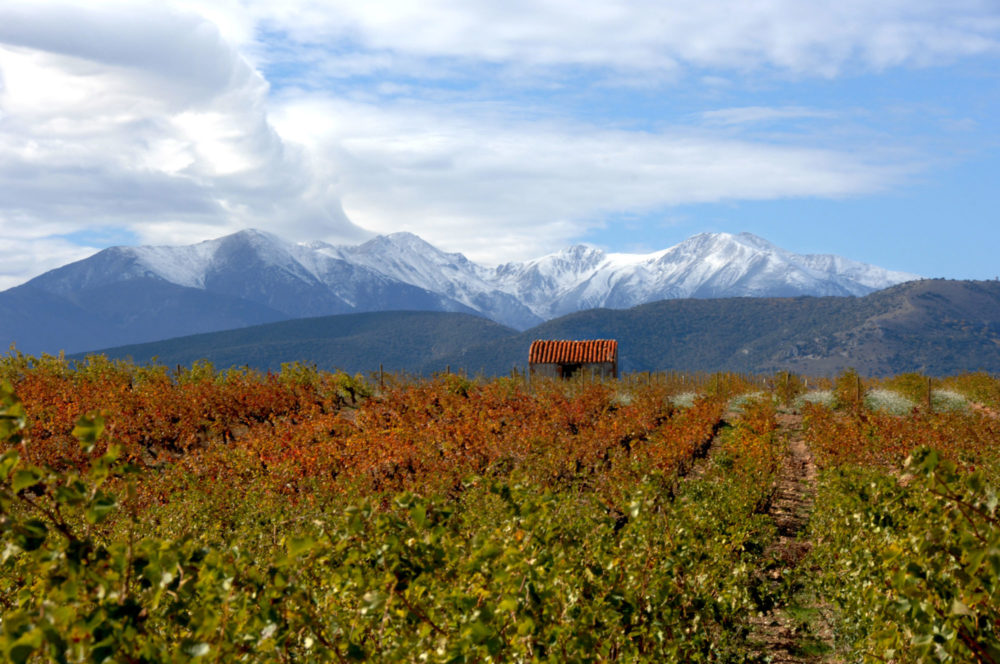
This small report focuses on some of my favorite estates in the Roussillon and includes a number of bottled 2016s as well an early look at a handful of 2017s.
The 2016 vintage in the Roussillon was another hot, incredibly dry, low yielding year that resulted in powerful yet surprisingly fresh and pure wines that rank up with some of the best I’ve tasted from the region. Looking at the weather, there was little in the way of precipitation through the winter and spring, and the following hot, dry summer resulted in tiny berry sizes and stunted canopies. As in the southern Rhône however, cool nighttime temperatures late in the summer and through harvest helped the grapes retain acidity and freshness, and the vignerons who waited for true phenolic ripeness made truly brilliant wines. These are rich, powerful wines, yet they possess a shocking level of freshness and purity, as well as terrific overall balance and tannin quality. These are classic Roussillon wines that reflect their terroir beautifully.
While I wasn’t able to taste extensively, the 2017 vintage was another hot, incredibly early vintage (harvest started two weeks ahead of 2016), yet large winter and early springtime rains helped replenish the water table and rejuvenated the vines. The 2017s don’t appear to have the density of the 2016s yet they possess beautiful, upfront, charming characters that are going to drink nicely right out of the gate.
Lastly, the level of investment – and winemaking talent – continues to soar in Roussillon, and it’s readily apparent in the wines. While the region has always had the ability to produce rich, powerful wines, they often lacked finesse and elegance. That’s no longer the case today, and as I hope these reviews show, there are world-class wines coming from the Roussillon today. Do yourself a favor and give these wines a try.
A Quick Overview of the Regions of the Roussillon
Looking quickly at the different AOCs of the Roussillon, the two largest regions are the IGP Côtes Catalanes and AOC Côtes du Roussillon which cover 3,814 and 4,473 hectares respectively. The IGP Côtes Catalanes is a catch-all classification and covers roughly the same areas as the AOC Côtes du Roussillon Villages while giving winemakers much more flexibility with regards to blend and winemaking regulations. Winemakers wanting to focus on single variety wines are forced to use IGP Côtes Catalanes, and some vignerons have completely abandoned the AOC in favor of this designation.
The AOC Côtes du Roussillon lies mostly in the southern part of the Roussillon (it overlaps the Aspres terroir) and includes part of the Agly Valley and the Fenouillèdes in the north, as well as a coastal strip along the Mediterranean in the east. Most estates use this designation for their entry level releases and reds, roses and whites are allowed.
Located to the south and west of Perpignan, in the southern part of the Roussillon, the AOC Côtes du Roussillon Les Aspres was created in 2003 and covers 102 hectares. This area is largely comprised of flat to rolling hills, and the soils are made up of gravelly clay, rolled pebbles, and small amounts of limestone. The wines are required to have 12 months of elevage, and Syrah and Mourvèdre are the most widely planted varieties.
The AOC Côtes du Roussillon Villages spans 1,741 hectares, primarily in the northern part of the Roussillon, and includes four specific villages identified for their unique terroir: Latour de France, Caramany, Lesquerde, and Tautavel. Soil types can be broken down as follows: Latour de France: Brown Schist; Caramany: Gneiss and Granite; Lesquerde: Granite (some of the most exciting Syrahs come from this village); and Tautavel: Red Clay and Limestone. All of these AOCs allow only red wines to be produced and the allowed varieties mirror that of the AOC Côtes du Roussillon. An exception being that Mourvèdre is not allowed under the AOC Côtes du Roussillon Villages Caramany and AOC Côtes du Roussillon Villages Lesquerde.
The recently created AOC Maury Sec is in the northern part of the Agly Valley and covers a tiny 185 hectares. This AOC is designated for dry reds made from the incredible black schist soils located around the village of Maury. Grenache is king in the region, and these wines tend to be rich, powerful, and opulent, with the top wines rivaling anything coming out of the Southern Rhône Valley today.
Finally, the AOC Collioure lies in the southernmost sector of the Roussillon, around the seaside villages of Collioure, Banyuls, Port-Vendres, and Cerbère, and covers 325 hectares. This region is comprised of steep, pure schist slopes facing the Mediterranean and produces perfumed, elegant reds, whites, and roses based largely on Grenache (which has to be over 60% of the blend.)
The Wines
All of these wines were tasted during a quick trip through the Roussillon in July of 2018.
Happy hunting!
Jeb

